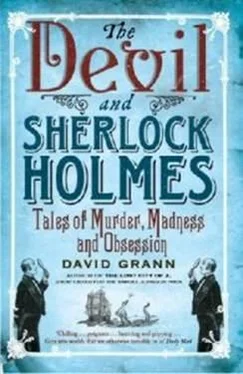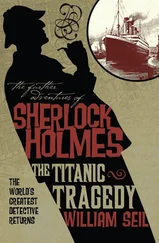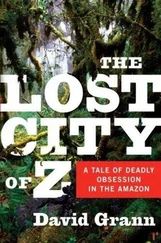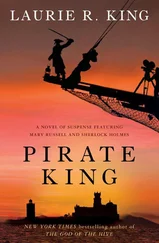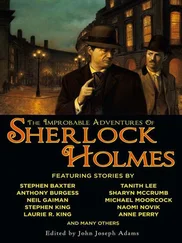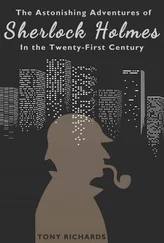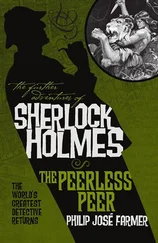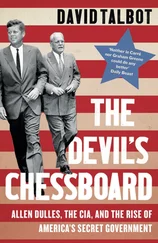And there is now the additional threat of terrorism. Although the public’s attention has focussed on the danger of someone’s poisoning the water supply, officials believe that the system would likely dilute a toxin’s effects. The greater danger, they say, is that a terrorist might blow up one of the pipelines before the third water tunnel is up and running. “That’s the scary thing,” Ward said. Fitzsimmons, the sandhogs’ union leader, added, “If you attacked the right spots-I hate to say this, but it’s true-you could take out all of the water going into New York City.”
On the morning that I went down the hole with John Ryan, he told me, “My hope is that we can finish the third water tunnel, so my father will be able to see it completed.”
The mole was boring into the rock. Several sandhogs had laid new tracks on the floor, pounding them into the rock with sledgehammers.
“All right!” Ryan yelled. “Let’s check the cutter heads.”
He looked up at me from under his hard hat. “You want to go?” he asked.
“Where?”
He pointed underneath the mole, where a small passageway led into the bowels of the machine. Two other sandhogs were already crawling in and, after a moment, I followed. First we had to crouch in a cavity no more than three feet by four feet. One of the sandhogs, who introduced himself as Peter, fumbled with the lamp on his hard hat. “Fucking thing’s busted,” he said.
The other worker turned his light on, and I could see that the passage led to a five-foot-long corridor that connected to the head of the mole.
“Whenever you’re ready, John,” Peter yelled to Ryan, who was outside the cavity, directing the operation. “You can roll the head.”
We stayed in a crouch for several more minutes, watching the mole’s cutters rotate several degrees one way, then the other, until at last they came to rest.
“This is the most dangerous part,” Peter said. He then lay on his stomach and stuck his hands straight out in front of him and began to squirm, feet first, through the narrow passage leading to the mole’s cutters. He slid through the mud and water, and I followed on my stomach. Soon, I was standing in mud and water up to my knees, staring at the giant metal blades. I tried to step away, but my back hit something hard: the head of the tunnel. We were sandwiched between the mole and the rock. “You just don’t want anything to move,” Peter said.
As groundwater seeped from the ceiling, hitting the machine, puffs of steam filled the cavity.
“Go ahead, touch it,” Peter said, pointing to one of the blades.
I reached out and touched the edge: it was scalding hot, from friction. “You could fry an egg on it,” Peter said.
The other sandhog squeezed into the crevice. Now the only wiggle room was above our heads. As the water crept up to our thighs, Peter craned his neck, inspecting the front of the tunnel to make sure the rock was sound. There was a series of grooved concentric circles where the blades had cut. “It looks like a dartboard, doesn’t it?” Peter said.
“Like a tree,” the other sandhog said.
They checked the blades to make sure they didn’t require replacement.
I told them I thought I needed to leave.
“Just a second more,” Peter said.
The other sandhog exited first, followed by me, then Peter. When I saw John Ryan again, he looked at my muck-covered clothes, then clapped me cheerfully on the back. “Welcome to our fucking world,” he said.
There was no man-trip car to take me back to the shaft, so I set out by myself, walking the length of the tunnel. “If you see a muck car coming,” Ryan told me, “just hang on to the pipes on the side of the tunnel.”
A few minutes later, the noise from the mole faded, and the tunnel was empty and still. Though it extended as far as the eye could see, this tunnel was not even one-sixtieth the projected length of the third water tunnel; it was a mere one-thousandth of all the miles of water tunnels and pipelines and aqueducts combined. For the first time during my underground excursion, I had some sense of this city under the city-of what many engineers refer to as “the eighth wonder of the world.”
After a while, a light flickered in the distance and I thought it was a muck car. As Ryan had instructed, I hung on to the pipes on the side of the tunnel. But it was only a sandhog come to escort me out.
When I reached the top, I went into the hog house to change. On the bench beside me was a slender boy with a hard hat cocked to one side, as if it were a fedora. He looked astonishingly like Jimmy Ryan. It was Jimmy’s younger son, Greg. “I started in 2000, over on the third water tunnel in Queens,” he said. “They call us the millennial hogs.”
Only twenty, he looked like a slightly ungainly teen-ager in his dirty white shirt and a slicker that seemed too loose for his narrow waist. He hung his Yankees cap in his locker and wrapped his supper, a veal cutlet sandwich, in a plastic bag. “It saves time to eat underground,” he said.
Greg glanced at another sandhog who was dressing nearby. His left hand had been crushed under a beam in the hole, and his index finger was missing. “I still get scared sometimes,” Greg said, lifting his hard hat and removing a pack of menthol cigarettes. He lit one and let it dangle between his teeth, the way he had often seen his father do. “My father told me not to think about it. It’ll only make it worse.”
Greg turned and headed outside, where his brother John was emerging from the cage, his face covered in mud. As John stepped onto solid ground, shielding his eyes from the blinding light, he clapped his hand on Greg’s shoulder. “I’ll see you, O.K.?” Greg nodded and, without a word, descended into the darkness.
– September, 2003
The Old Man and the Gun
THE SECRETS OF A LEGENDARY STICKUP MAN
Just before Forrest Tucker turned seventy-nine, he went to work for the last time. Although he was still a striking-looking man, with intense blue eyes and swept-back white hair, he had a growing list of ailments, including high blood pressure and burning ulcers. He had already had a quadruple bypass, and his wife encouraged him to settle into their home in Pompano Beach, Florida, a peach-colored house on the edge of a golf course which they’d purchased for their retirement. There was a place nearby where they could eat prime rib and dance on Saturday nights with other seniors for $15.50 a person, and even a lake where Tucker could sit by the shore and practice his saxophone.
But on this spring day in 1999, while his neighbors were on the fairway or tending to their grandchildren, he drove to the Republic Security Bank in Jupiter, about fifty miles from his home. Tucker, who took pride in his appearance, was dressed all in white: white pants with a sharp crease, a white sports shirt, white suède shoes, and a shimmering white ascot.
He paused briefly in front of the A.T.M. and pulled the ascot up around his face, bandit style. He then reached into a canvas bag, took out an old U.S. Army Colt.45, and burst into the bank. He went up to the first teller and said, “Put your money on the counter. All of it.”
He flashed the gun so that everyone could see it. The teller laid several packets of fives and twenties on the counter, and Tucker inspected them for exploding dye packs. Checking his watch, he turned to the next teller and said, “Get over here. You, too.”
Then he gathered up the thick packets-more than five thousand dollars-and hurried to the door. On his way out, he looked back at the two tellers. “Thank you,” he said. “Thank you.”
He drove to a nearby lot, where he had left a “safe” car, a red Grand Am that couldn’t be traced to him. After wiping down the stolen “hot” car with a rag, he threw his belongings inside the Grand Am. They included a.357 Magnum, a sawed-off.30 carbine, two black nylon caps, a holster, a can of Mace, a pair of Smith & Wesson handcuffs, two rolls of black electrical tape, a police badge, five AAA batteries, a police scanner, a glass cutter, gloves, and a fishing cap. There was also a small bottle of medicine for his heart. No one seemed to notice him, and he went home, making what appeared to be a clean getaway.
Читать дальше
